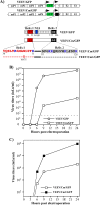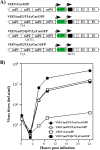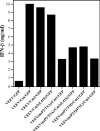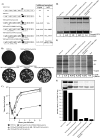Venezuelan equine encephalitis virus nsP2 protein regulates packaging of the viral genome into infectious virions
- PMID: 23365438
- PMCID: PMC3624340
- DOI: 10.1128/JVI.03142-12
Venezuelan equine encephalitis virus nsP2 protein regulates packaging of the viral genome into infectious virions
Abstract
Alphaviruses are one of the most geographically widespread and yet often neglected group of human and animal pathogens. They are capable of replicating in a wide variety of cells of both vertebrate and insect origin and are widely used for the expression of heterologous genetic information both in vivo and in vitro. In spite of their use in a range of research applications and their recognition as a public health threat, the biology of alphaviruses is insufficiently understood. In this study, we examined the evolution process of one of the alphaviruses, Venezuelan equine encephalitis virus (VEEV), to understand its adaptation mechanism to the inefficient packaging of the viral genome in response to serial mutations introduced into the capsid protein. The new data derived from this study suggest that strong alterations in the ability of capsid protein to package the viral genome leads to accumulation of adaptive mutations, not only in the capsid-specific helix I but also in the nonstructural protein nsP2. The nsP2-specific mutations were detected in the protease domain and in the amino terminus of the protein, which was previously proposed to function as a protease cofactor. These mutations increased infectious virus titers, demonstrated a strong positive impact on viral RNA replication, mediated the development of a more cytopathic phenotype, and made viruses capable of developing a spreading infection. The results suggest not only that packaging of the alphavirus genome is determined by the presence of packaging signals in the RNA and positively charged amino acids in the capsid protein but also that nsP2 is either directly or indirectly involved in the RNA encapsidation process.
Figures








References
-
- Weaver SC, Frolov I. 2005. Togaviruses, p 1010–1024 In Mahy BWJ, Meulen VT. (ed), Virology, vol 2 ASM Press, Salisbury, United Kingdom
-
- Dal Canto MC, Rabinowitz SG. 1981. Central nervous system demyelination in Venezuelan equine encephalomyelitis infection. J. Neurol. Sci. 49:397–418 - PubMed
-
- Alevizatos AC, McKinney RW, Feigin RD. 1967. Live, attenuated Venezuelan equine encephalomyelitis virus vaccine. I. Clinical effects in man. Am. J. Trop. Med. Hyg. 16:762–768 - PubMed
Publication types
MeSH terms
Substances
Grants and funding
LinkOut - more resources
Full Text Sources
Other Literature Sources

